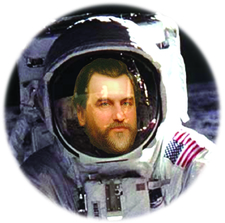If a group of alumni and faculty have their way, the next overseas studies destination for undergraduates could be the moon.
At a conference held in early October, more than 100 alumni, faculty and administrators gathered to discuss Stanford’s future role in lunar exploration. The conference was hosted by Stanford on the Moon, an alumni initiative founded by members of the class of 1965, and was the latest event in the group’s five-year campaign to increase Stanford’s lunar presence.
“The goal is to show that the Stanford community is again a world leader in innovation,” said Engineering Prof. Bob Twiggs, a member of Stanford on the Moon. “We believe it to be a worthwhile, achievable goal with the expertise we have within Stanford.”
Initiated by alum Steve Durst at his reunion homecoming in 2000, the project has expanded in recent years to include administrators, students and faculty from a number of departments. Durst, who now edits and publishes the Palo Alto-based news service Space Age Publishing, said he hopes to use Stanford’s scientific strengths to participate in global lunar talks.
“Stanford has always had an outstanding record of graduates who become astronauts,” Durst said. “But outside a select group of individuals, it hasn’t had a very strong interest in the moon. In general, lunar interest from the engineering departments has been consistent with the national attitude. But the moon is now rising in a lot of dimensions, and we’ll see whether Stanford will rise to that challenge.”
Durst said he believed that continued work with the Bing Overseas Studies Program (BOSP) could result in an eventual campus on the moon.
“We are continuing to build connections with BOSP and much of it right now is just departmental progress,” Durst said. “But in time why not a Stanford program on the moon? That’s a big vision, but if we work at it, it’s possible.”
But don’t bank on a Bing trip to Mars just yet. While undergraduate space travel may be some years off, Stanford on the Moon is also working on more immediately feasible ideas like lunar orbitals, robotic experiments and geology research. Engineering Prof. Bruce Lusignan said he believed that lunar exploration could lead to more extensive space studies.
“The moon is an important site to improve radio observation,” Lusignan said. “There is also geologic evidence of the formation of the solar system. By extension of cooperation, the exploration of Mars could take place.”
One specific plan is the Stanford Lunar Analysis Mission (SLAM), an initiative to place small 10-centimeter-long satellites, known as CubeSats, into orbit around the moon.
“We would actually like to do a lunar flyby by 2010,” said Twiggs, who developed SLAM. “These CubeSats would be launched by a carrier as it nears the moon to have them get a gravity-assisted swing around the moon and fly by the earth, then out into space. We know of at least four other groups involving universities that have the same goal and may beat our 2010 date.”
For the last five years, Twiggs has been working with students on a satellite program that has successfully launched three satellites into space. Twiggs said he hoped collaboration on the satellite projects would remain confined to the University.
“We hope the funding for the project can be generated internally within the Stanford community so it can be kept a total Stanford project,” Twiggs said. “If we cannot find the funds within Stanford, then we will make it a collaborative project with government, industry and other university projects.”
Stanford on the Moon has also raised the possibility of manned missions to the moon. The U.S., China and Russia have all recently announced that they plan to send astronauts to the moon in the near future, prompting a surge in lunar interest and competition.
Lusignan said that he believed the international community’s focus on the moon would encourage further funding for lunar exploration.
“It is clear that the combined budgets of Europe, Russia, China, Japan and other nations can support a manned moon mission without any increase,” Lusignan said. “And from their announcements, this is clearly underway, with or without the U.S. While NASA’s budget has been slashed, there are many private persons that will participate even if the U.S chooses not to.”
While only the Engineering Department has contributed to the lunar project so far, Durst said that he hopes faculty and students from all disciplines will get involved in the near future.
“It’s time for us to engage new, broader sections of the University community in this project.” Durst said. “I was a history major at Stanford, and I want to bring the humanities into this effort.”


 SMS
SMS RSS feeds
RSS feeds


 Enlarge
Enlarge
